Gait Symmetry Analysis in Patients after Treatment of Pilon Fractures by the Ilizarov Method
Abstract
1. Introduction
2. Materials and Methods
2.1. Patient Recruitment
2.2. Gait Analysis
- Maximum forefoot force (%) as a percentage of body weight
- Maximum hindfoot force (%) as a percentage of body weight
- Step length (cm)—the distance from the heel print of one foot to the heel print of the next foot during a walking stride
- Stance phase (%)―the period of time during which the foot is in contact with the ground
- Swing phase (%)―the period of time during which the foot is not in contact with the ground
- Step time (s)―the phase of the gait cycle between the contact of one heel with the ground and the contact of the other heel with the ground
- Stride time (s)―the time between the first contact of two consecutive footsteps of the left and the right feet
- Cadence step―step rate per minute
- Velocity (km/h)―the speed of walking.
2.3. Statistical Analysis
3. Results
4. Discussion
5. Conclusions
Author Contributions
Funding
Institutional Review Board Statement
Informed Consent Statement
Data Availability Statement
Conflicts of Interest
References
- Kelsey, J.L.; Samelson, E.J. Variation in Risk Factors for Fractures at Different Sites. Curr. Osteoporos. Rep. 2009, 27–133. [Google Scholar] [CrossRef] [PubMed]
- Holloway, K.L.; Yousif, D.; Bucki-Smith, G.; Hosking, S.; Betson, A.G.; Williams, L.J.; Brennan-Olsen, S.L.; Kotowicz, M.A.; Sepetavc, A.; Pasco, J.A. Lower Limb Fracture Presentations at a Regional Hospital. Arch. Osteoporos. 2017, 12. [Google Scholar] [CrossRef] [PubMed]
- Papadokostakis, G.; Kontakis, G.; Giannoudis, P.; Hadjipavlou, A. External Fixation Devices in the Treatment of Fractures of the Tibial Plafond: A Systematic Review of the Literature. J. Bone Jt. Surg.-Ser. B 2008, 90, 1–6. [Google Scholar] [CrossRef] [PubMed]
- Villaseñor, L.E.; Olea Leyva, M.A.; Rodríguez Flores, R.; Hernández López, J.L. Clinical Outcome of a Bilateral Tibial Pylon Fracture Treated with a Minimally Invasive Technique. Acta Ortopédica Mex. 2009, 23, 163–166. [Google Scholar]
- Okcu, G.; Aktuglu, K. Intra-Articular Fractures of the Tibial Plafond. A Comparison of the Results Using Articulated and Ring External Fixators. J. Bone Jt. Surg.-Ser. B 2004, 868–875. [Google Scholar] [CrossRef] [PubMed]
- García-Balderas, A.; Beltrán-Cota, E.R.; Ruiz-Barrios, J.M.; Caldera-Barbosa, O. Results of the treatment of high energy tibial pylon fractures. Acta Ortopédica Mex. 2013, 27, 363–366. [Google Scholar]
- Závitkovský, P.; Malkus, T. Fractures of the Tibial Pylon: Treatment Options and Outcomes. Acta Chir. Orthop. Traumatol. Cech. 2004, 71, 228–22836. [Google Scholar]
- Aktuǧlu, K.; Özsoy, M.H.; Yensel, U. Treatment of Displaced Pylon Fractures with Circular External Fixators of Ilizarov. Foot Ankle Int. 1998, 19, 208–216. [Google Scholar] [CrossRef]
- Bastian, L.; Blauth, M.; Thermann, H.; Tscherne, H. Verschiedene Therapiekonzepte Bei Schweren Frakturen Des Pilon Tibiale (Typ-C-Verletzungen). Unfallchirurg 1995, 98, 551–558. [Google Scholar]
- Zheng, Y.; Zhang, J.D.; Shen, J.M.; Chen, J.J.; Toy, L.; Huang, J.F. A Modified 2-Stage Treatment for AO/OTA 43-C1 Pilon Fractures Accompanied by Distal Fibular and Posterior Lip of the Distal Tibia Fracture. J. Foot Ankle Surg. 2020, 59, 972–978. [Google Scholar] [CrossRef]
- Campbell, S.T.; Goodnough, L.H.; Salazar, B.; Lucas, J.F.; Bishop, J.A.; Gardner, M.J. How Do Pilon Fractures Heal? An Analysis of Dual Plating and Bridging Callus Formation. Injury 2020, 51, 1655–1661. [Google Scholar] [CrossRef]
- Malik-Tabassum, K.; Pillai, K.; Hussain, Y.; Bleibleh, S.; Babu, S.; Giannoudis, P.V.; Tosounidis, T.H. Post-Operative Outcomes of Open Reduction and Internal Fixation versus Circular External Fixation in Treatment of Tibial Plafond Fractures: A Systematic Review and Meta-Analysis. Injury 2020, 1448–1456. [Google Scholar] [CrossRef]
- Falzarano, G.; Pica, G.; Medici, A.; Rollo, G.; Bisaccia, M.; Cioffi, R.; Pavone, M.; Meccariello, L. Foot Loading and Gait Analysis Evaluation of Nonarticular Tibial Pilon Fracture: A Comparison of Three Surgical Techniques. J. Foot Ankle Surg. 2018, 57, 894–898. [Google Scholar] [CrossRef]
- Jansen, H.; Fenwick, A.; Doht, S.; Frey, S.; Meffert, R. Clinical Outcome and Changes in Gait Pattern after Pilon Fractures. Int. Orthop. 2013, 37, 51–58. [Google Scholar] [CrossRef]
- Czamara, A.; Markowska, I.; Królikowska, A.; Szopa, A.; Domagalska Szopa, M. Kinematics of Rotation in Joints of the Lower Limbs and Pelvis during Gait: Early Results—SB ACLR Approach versus DB ACLR Approach. Biomed. Res. Int. 2015, 2015. [Google Scholar] [CrossRef]
- Królikowska, A.; Sikorski, Ł.; Czamara, A.; Reichert, P. Effects of Postoperative Physiotherapy Supervision Duration on Clinical Outcome, Speed, and Agility in Males 8 Months after Anterior Cruciate Ligament Reconstruction. Med. Sci. Monit. 2018, 24, 6823–6831. [Google Scholar] [CrossRef] [PubMed]
- Morasiewicz, M.; Koprowski, P.; Wrzosek, Z.; Dragan, S. Gait analysis in patients after lengthening and correction of tibia with Ilizarov technique. Fizjoterapia 2010, 18, 9–18. [Google Scholar] [CrossRef]
- Butler, R.J.; Barrios, J.A.; Royer, T.; Davis, I.S. Frontal-Plane Gait Mechanics in People with Medial Knee Osteoarthritis Are Different from Those in People with Lateral Knee Osteoarthritis. Phys. Ther. 2011, 91, 1235–1243. [Google Scholar] [CrossRef] [PubMed]
- Cichy, B.; Wilk, M. Gait Analysis in Osteoarthritis of the Hip. Med. Sci. Monit. 2006, 12, 507–513. [Google Scholar]
- Klöpfer-Krämer, I.; Brand, A.; Wackerle, H.; Müßig, J.; Kröger, I.; Augat, P. Gait Analysis—Available Platforms for Outcome Assessment. Injury 2020, 51, S90–S96. [Google Scholar] [CrossRef] [PubMed]
- Aiona, M.; Do, K.P.; Emara, K.; Dorociak, R.; Pierce, R. Gait Patterns in Children with Limb Length Discrepancy. J. Pediatric Orthop. 2015, 35, 280–284. [Google Scholar] [CrossRef] [PubMed]
- Fenwick, A.; Kröger, N.; Jovic, S.; Hölscher-Doht, S.; Meffert, R.; Jansen, H. Pedobarography Shows No Differences in Gait after Talar Fractures. Technol. Health Care 2020, 28, 85–92. [Google Scholar] [CrossRef] [PubMed]
- Lee, S.H.; Lee, O.S.; Teo, S.H.; Lee, Y.S. Change in Gait after High Tibial Osteotomy: A Systematic Review and Meta-Analysis. Gait Posture 2017, 57, 57–68. [Google Scholar] [CrossRef]
- Shrader, M.W.; Draganich, L.F.; Pottenger, L.A.; Piotrowski, G.A. Effects of Knee Pain Relief in Osteoarthritis on Gait and Stair-Stepping. Clin. Orthop. Relat. Res. 2004, 421, 188–193. [Google Scholar] [CrossRef]
- Saraph, V.; Zwick, E.B.; Steinwender, G.; Auner, C.; Schneider, F.; Linhart, W. Leg Lengthening as Part of Gait Improvement Surgery in Cerebral Palsy: An Evaluation Using Gait Analysis. Gait Posture 2006, 23, 83–90. [Google Scholar] [CrossRef]
- Genc, Y.; Gultekin, A.; Duymus, T.M.; Mutlu, S.; Mutlu, H.; Komur, B. Pedobarography in the Assessment of Postoperative Calcaneal Fracture Pressure with Gait. J. Foot Ankle Surg. 2016, 55, 99–105. [Google Scholar] [CrossRef]
- Manjra, M.A.; Naude, J.; Birkholtz, F.; Glatt, V.; Tetsworth, K.; Hohmann, E. The Relationship between Gait and Functional Outcomes in Patients Treated with Circular External Fixation for Malunited Tibial Fractures. Gait Posture 2019, 68, 569–574. [Google Scholar] [CrossRef]
- Bhave, A.; Paley, D.; Herzenberg, J.E. Improvement in Gait Parameters after Lengthening for the Treatment of Limb-Length Discrepancy. J. Bone Jt. Surg.-Ser. A 1999, 81, 529–534. [Google Scholar] [CrossRef] [PubMed]
- Song, K.M.; Halliday, S.E.; Little, D.G. The Effect of Limb-Length Discrepancy on Gait. J. Bone Jt. Surg.-Ser. A 1997, 79, 1690–1698. [Google Scholar] [CrossRef] [PubMed]
- Suciu, O.; Onofrei, R.R.; Totorean, A.D.; Suciu, S.C.; Amaricai, E.C. Gait Analysis and Functional Outcomes after Twelve-Week Rehabilitation in Patients with Surgically Treated Ankle Fractures. Gait Posture 2016, 49, 184–189. [Google Scholar] [CrossRef]
- Wu, W.L.; Su, F.C.; Cheng, Y.M.; Huang, P.J.; Chou, Y.L.; Chou, C.K. Gait Analysis after Ankle Arthrodesis. Gait Posture 2000, 11, 54–61. [Google Scholar] [CrossRef]
- Karol, L.A.; Haideri, N.F.; Halliday, S.E.; Smitherman, T.B.; Johnston, C.E. Gait Analysis and Muscle Strength in Children with Congenital Pseudarthrosis of the Tibia: The Effect of Treatment. J. Pediatric Orthop. 1998, 18, 381–386. [Google Scholar] [CrossRef]
- Morasiewicz, P.; Dragan, S.; Dragan, S.Ł.; Wrzosek, Z.; Pawik, Ł. Pedobarographic Analysis of Body Weight Distribution on the Lower Limbs and Balance after Ilizarov Corticotomies. Clin. Biomech. 2016, 31, 2–6. [Google Scholar] [CrossRef]
- Morasiewicz, P.; Konieczny, G.; Dejnek, M.; Morasiewicz, L.; Urbański, W.; Kulej, M.; Dragan, S.Ł.; Dragan, S.F.; Pawik, Ł. Pedobarographic Analysis of Body Weight Distribution on the Lower Limbs and Balance after Ankle Arthrodesis with Ilizarov Fixation and Internal Fixation. Biomed. Eng. Online 2018, 17, 174. [Google Scholar] [CrossRef]
- Morasiewicz, P.; Konieczny, G.; Dejnek, M.; Urbański, W.; Dragan, S.Ł.; Kulej, M.; Dragan, S.F.; Pawik, Ł. Assessment of the Distribution of Load on the Lower Limbs and Balance before and after Ankle Arthrodesis with the Ilizarov Method. Sci. Rep. 2018, 8, 15693. [Google Scholar] [CrossRef]
- Lorkowski, J.; Trybus, M.; Hładki, W.; Brongel, L. Underfoot Pressure Distribution of a Patient with Unilateral Ankylosis of Talonavicular Joint during Rheumatoid Arthritis—Case Report. Przegla̧d Lek. 2008, 65, 54–56. [Google Scholar]
- Coren, S. The Lateral Preference Inventory for Measurement of Handedness, Footedness, Eyedness, and Earedness: Norms for Young Adults. Bull. Psychon. Soc. 1993, 31, 1–3. [Google Scholar] [CrossRef]
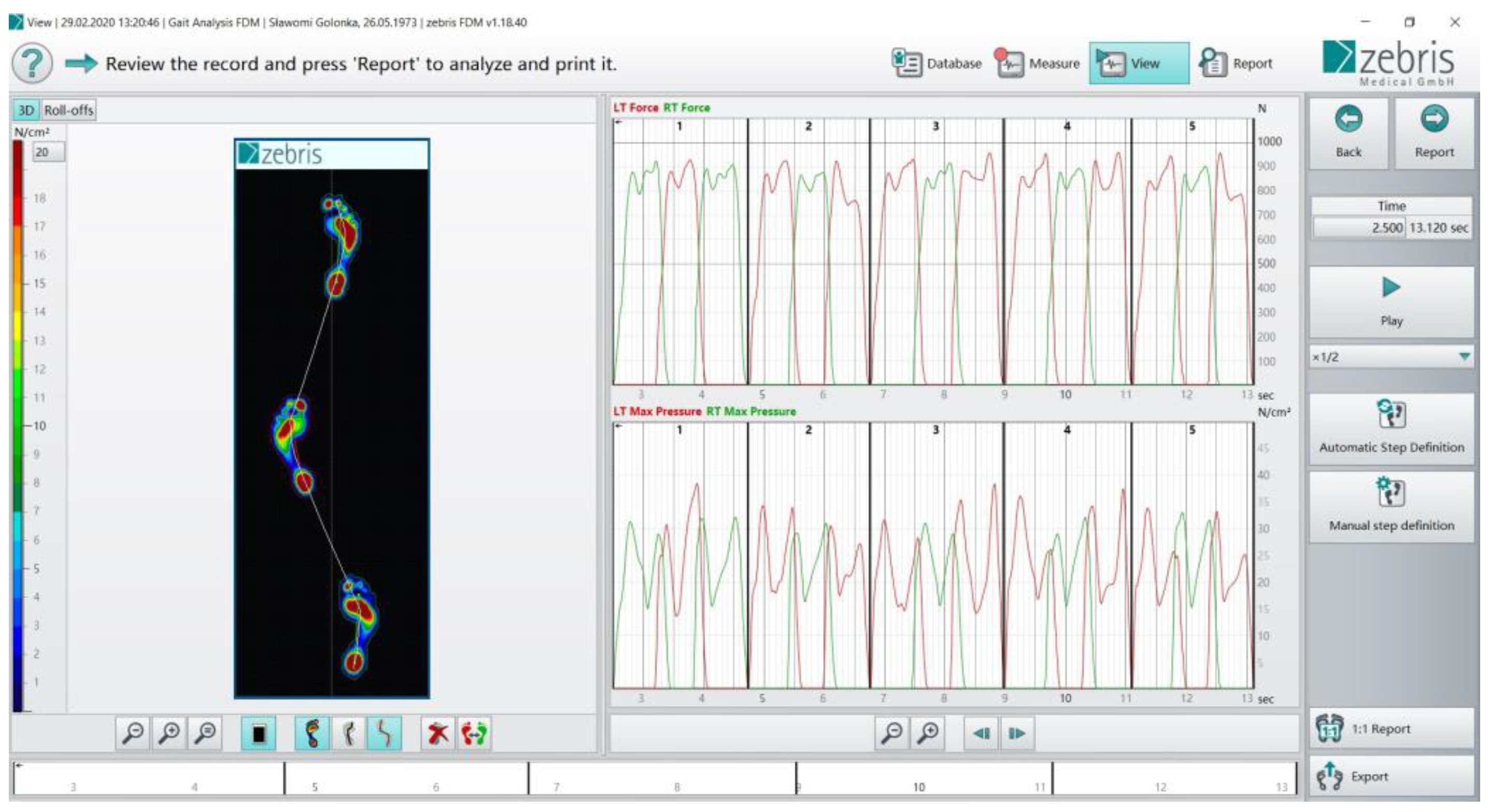
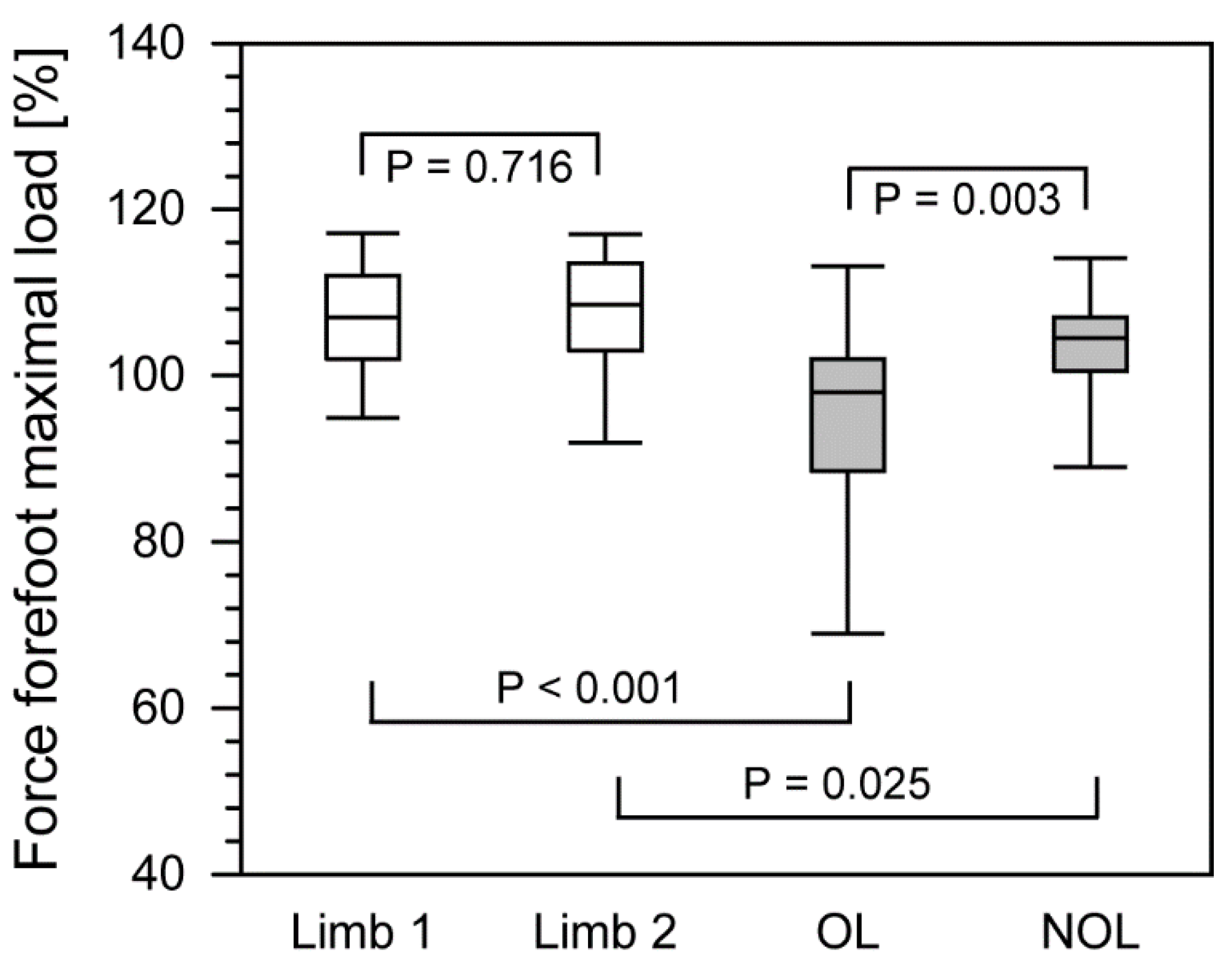
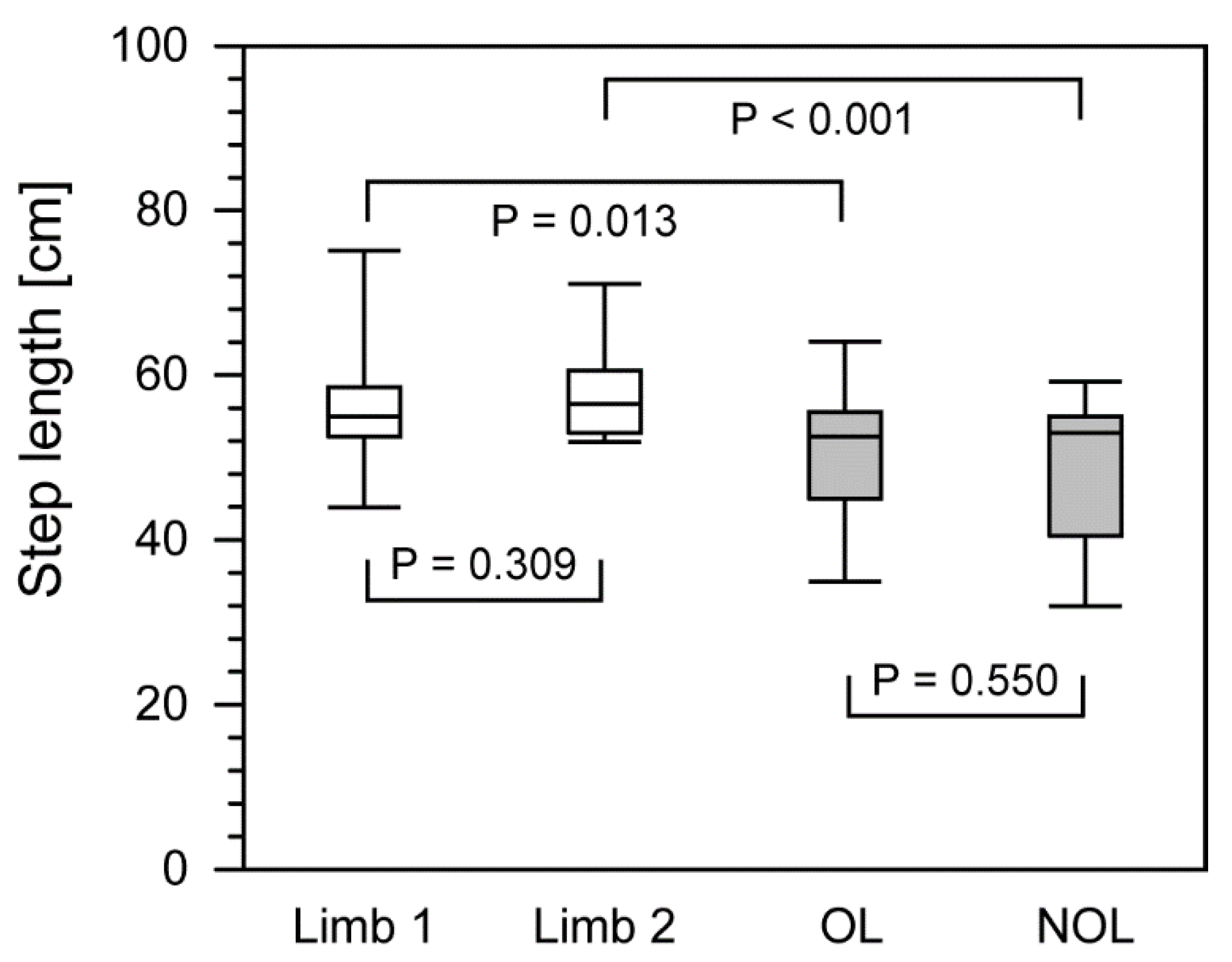
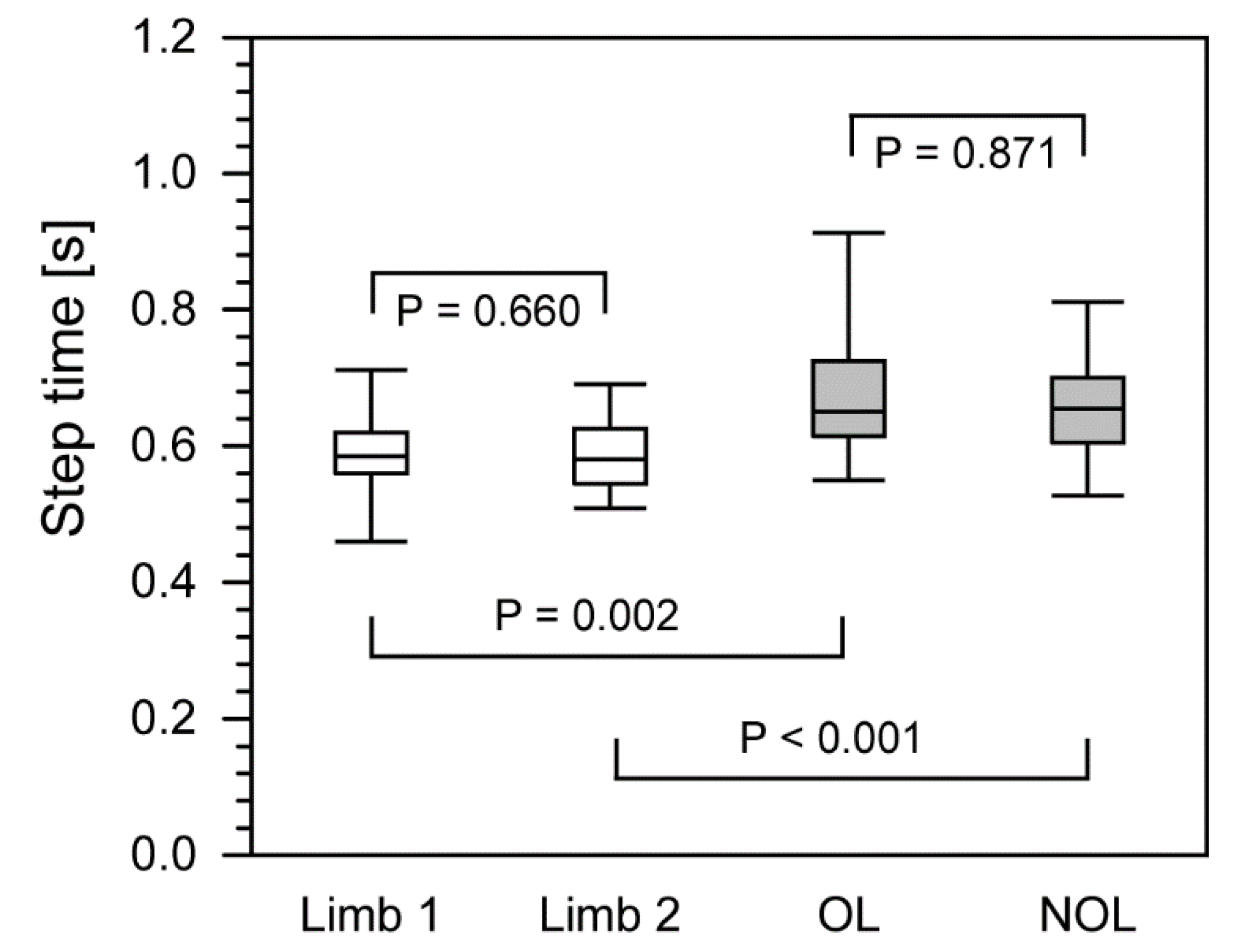
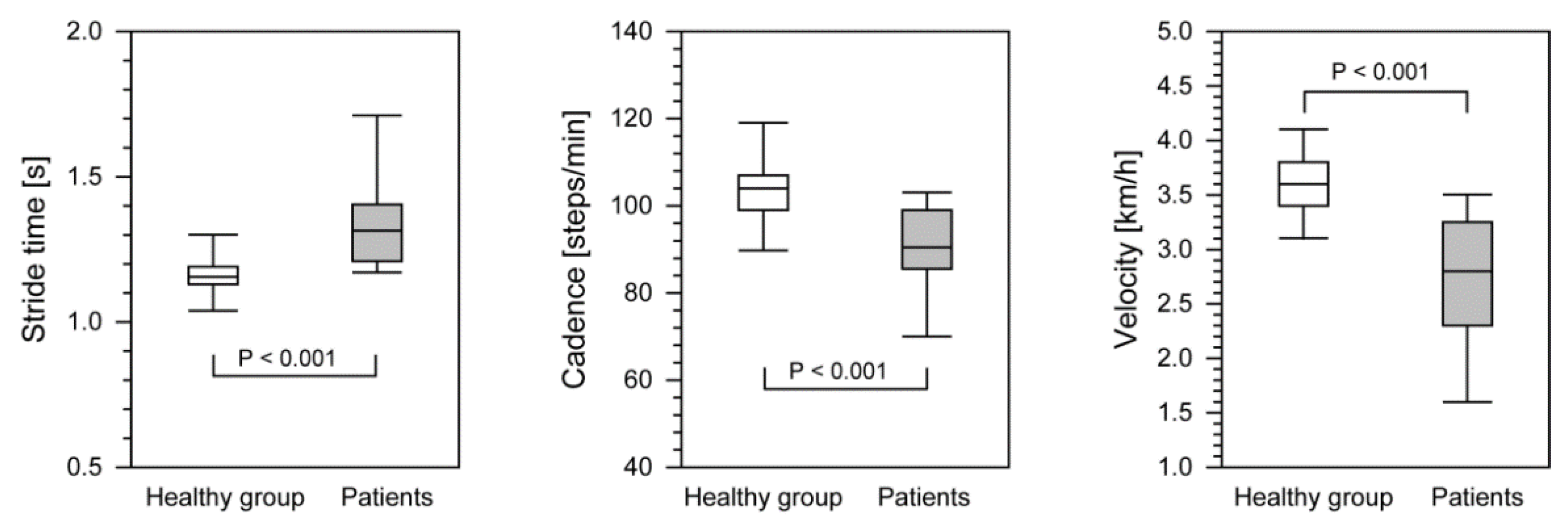
| Control Group (n = 32) | Patients after Surgery (n = 20) | p | |
|---|---|---|---|
| Age [years] | 50.5 (34.0–77.7) | 47.0 (25.2–78.6) | 0.386 |
| Height [cm] | 172.5 (158.3–187.7) | 174.0 (160.1–189.6) | 0.546 |
| Body mass [kg] | 79.5 (56.0–99.8) | 82.5 (62.0–98.0) | 0.328 |
| BMI [kg/m2] | 27.2 (21.6–36.4) | 26.5 (23.2–33.8) | 0.430 |
| Control Group (n = 32) | Patients after Surgery (n = 20) | p | |
|---|---|---|---|
| Force Forefoot max load OL [%] | 107.0 (95.6–117.0) | 98.0 (69.5–112.6) | <0.001 |
| Force Forefoot max load NOL [%] | 108.5 (93.9–117.0) | 104.5 (89.1–114.0) | 0.025 |
| p | 0.716 | 0.003 | |
| Force Backfoot max load OL [%] | 79.5 (67.6–89.3) | 75.5 (60.0–93.7) | 0.391 |
| Force Backfoot max load NOL [%] | 77.5 (70.0–89.4) | 80.0 (48.7–97.5) | 0.407 |
| p | 0.396 | 0.579 | |
| Step length OP [cm] | 55.0 (47.2–69.1) | 52.5 (35.2–63.8) | 0.013 |
| Step length NOP [cm] | 56.5 (52.0–70.3) | 53.0 (32.0–58.9) | <0.001 |
| p | 0.309 | 0.550 | |
| Stance phase OL [%] | 63.9 (57.7–71.8) | 64.6 (61.2–70.6) | 0.342 |
| Stance phase NOL [%] | 65.2 (57.5–68.4) | 65.7 (59.3–70.6) | 0.486 |
| p | 0.151 | 0.685 | |
| Swing phase OL [%] | 35.9 (30.7–42.5) | 35.3 (29.4–38.8) | 0.318 |
| Swing phase NOL [%] | 34.9 (31.5–42.3) | 34.2 (29.4–40.7) | 0.263 |
| p | 0.655 | 0.685 | |
| Step time OL [s] | 0.585 (0.460–0.703) | 0.650 (0.550–0.904) | 0.002 |
| Step time NOL [s] | 0.580 (0.460–0.703) | 0.650 (0.530–0.807) | <0.001 |
| p | 0.660 | 0.871 |
| Gait Parameters | Control Group (n = 32) | Patients after Surgery (n = 20) | p |
|---|---|---|---|
| Stride time (s) | 1.15 (1.06–1.27) | 1.31 (1.17–1.70) | <0.001 |
| Cadence steps/min | 104.0 (90.0–112.5) | 90.5 (70.4–102.9) | <0.001 |
| Velocity (km/h) | 3.60 (3.16–3.97) | 2.80 (1.61–3.49) | <0.001 |
Publisher’s Note: MDPI stays neutral with regard to jurisdictional claims in published maps and institutional affiliations. |
© 2021 by the authors. Licensee MDPI, Basel, Switzerland. This article is an open access article distributed under the terms and conditions of the Creative Commons Attribution (CC BY) license (http://creativecommons.org/licenses/by/4.0/).
Share and Cite
Pawik, Ł.; Wietecki, P.; Leśkow, A.; Pajchert Kozłowska, A.; Żarek, S.; Górski, R.; Pawik, M.; Fink-Lwow, F.; Urbański, W.; Morasiewicz, P. Gait Symmetry Analysis in Patients after Treatment of Pilon Fractures by the Ilizarov Method. Symmetry 2021, 13, 349. https://doi.org/10.3390/sym13020349
Pawik Ł, Wietecki P, Leśkow A, Pajchert Kozłowska A, Żarek S, Górski R, Pawik M, Fink-Lwow F, Urbański W, Morasiewicz P. Gait Symmetry Analysis in Patients after Treatment of Pilon Fractures by the Ilizarov Method. Symmetry. 2021; 13(2):349. https://doi.org/10.3390/sym13020349
Chicago/Turabian StylePawik, Łukasz, Paweł Wietecki, Artur Leśkow, Andżelika Pajchert Kozłowska, Sławomir Żarek, Radosław Górski, Malwina Pawik, Felicja Fink-Lwow, Wiktor Urbański, and Piotr Morasiewicz. 2021. "Gait Symmetry Analysis in Patients after Treatment of Pilon Fractures by the Ilizarov Method" Symmetry 13, no. 2: 349. https://doi.org/10.3390/sym13020349
APA StylePawik, Ł., Wietecki, P., Leśkow, A., Pajchert Kozłowska, A., Żarek, S., Górski, R., Pawik, M., Fink-Lwow, F., Urbański, W., & Morasiewicz, P. (2021). Gait Symmetry Analysis in Patients after Treatment of Pilon Fractures by the Ilizarov Method. Symmetry, 13(2), 349. https://doi.org/10.3390/sym13020349







